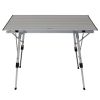Solinst Well-Mount Field Table
Features
- Connects to standard groundwater monitoring wells
- Quick and easy to deploy for an extra “hand” in the field
- Comes in a convenient carry bag that can hold other field gear
- Expedited repair and warranty service
- Lifetime technical support
- More
Overview
The Solinst Well-mount Field Table connects to the top of a standard groundwater monitoring well for easy access. The Well-mount Field Table uses a folding bracket that hooks onto the top of the well casing or enclosure, and is then supported by the side of the well. It is secured in place by tightening the two adjustable straps around the well or enclosure. It is ideal for standard groundwater monitoring 2" diameter wells and larger.
Design
The tabletop is 20.3 cm x 30.5 cm (8" x 12") in size, which is ideal for supporting manual water level measuring instruments such as Water Level Meters, Interface Meters, TLC Meters or other Solinst devices. The high-density polyethylene tabletop and stainless steel support bracket are rugged and constructed for field use. The adjustable straps are made from tough nylon and will hold up with repeated use. The Well-mount Field Table is lightweight (1.3 kg (2.9 lbs) and comes in a custom Solinst Field Accessories Bag that is padded and has extra compartments to store other field gear. When folded and in the bag, the Field Table measures less than 45.7 cm x 30.5 cm x 7.6 cm (18" x 12" x 3").
- (1) Well-mount field table
- (1) Carry bag
In The News
Monitoring and Facilitating Habitat Restoration Efforts in the Great Lakes
While human infrastructure, urbanization, and industrialization have advanced human societies, the natural environment has suffered due to constructed impediments and deteriorating architecture. In order to combat this degradation, habitat restoration programs across the US work to remove impairments and improve damaged waterways. [caption id="attachment_39162" align="aligncenter" width="940"] Barge electrofishing by state and federal employees prior to habitat restoration on Wiscoy Creek which is a tributary to the Genesee River. (Credit Thomas Hoffman)[/caption] Habitat Restoration Efforts in the Great Lakes Tom Hoffman, aquatic habitat restoration biologist in the Lower Great Lakes basin, directs restoration efforts within tributaries to Lake Erie, Lake Ontario, and the St.
Read MoreSustainable Fishing in Alaska: Protecting the Salmon Capital of the World through Research
In the far north, the Alaska Peninsula stretches away from the Last Frontier into the Pacific Ocean. A narrow strip of land dotted with freshwater lakes and intruded upon by ocean inlets–this unique region is intimately connected with the surrounding water. Nestled halfway down the peninsula's southern coast are the small villages of Chignik. The area has historically been home to the Aleut people and has been heavily reliant on fishing for centuries. Home to commercial and subsistence fishing today, Chignik continues to rely upon the salmon returns to the surrounding villages, which are supported by scientists working tirelessly to understand and steward these fish populations.
Read MoreNexSens X3 Data Logger Review
Extreme environments meet extreme design with the NexSens X3 Data Logger . The new logger offers the latest in real-time monitoring technology with wireless communication, a large plug-and-play sensor library and ultra-low power consumption, all in a waterproof marine-grade housing. The X3 is built to handle harsh weather, floods, high winds and rough seas, and it stands alone; no additional protective housing needed. With an operating temperature that ranges from -40°C to 70°C, the logger can withstand arctic environments and extreme heat. A conformal coating on the internal circuit board isolates it from moisture and humidity.
Read More







